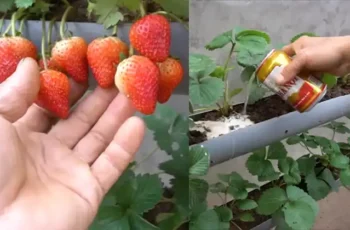Are you intrigued by the prospect of cultivating your own lemon trees but daunted by traditional gardening techniques? Don’t fret: this comprehensive guide offers an innovative and straightforward method for propagating lemon trees using just two liter plastic bottles and some essential materials. Let’s dive right in with this creative method that makes propagation fun rather than daunting!
Accumulating Your Supplies for Lemon Tree Propagation: Essential Materials Needed.
Before setting out on our exciting journey of turning an ordinary cutting into a flourishing tree, let’s collect all necessary tools and materials:
A two-liter plastic bottle: This will serve as the centerpiece of our innovative propagation method.
Sand or well-draining potting mix: To provide optimal conditions for root formation of lemon tree cuttings.
Lemon Tree Cuttings (6-8 Inches Long): For optimal success rates, always select healthy cuttings with nodes to ensure maximum survival rate of this cuttings.
Rooting hormone (optional): Although not mandatory, rooting hormone can accelerate root development and speed its process up considerably.
Sharp Knives or Scissors: for making cuts.
Rubber bands or twine: Used to secure plastic bottles into mini greenhouses.
Misting bottles/sprayer bottles: For optimal humidity levels.
Step-by-Step Guide to Lemon Tree Propagation Success
Let’s go through each step individually:
Step One: Select and Prep Cuttings for Assembly.
Select healthy lemon tree cuttings between 6-8 inches long that feature nodes for faster root development. Apply rooting hormone directly onto any cut ends if necessary for faster development of roots.
Step Two: Create Your Ideal Home Environment
Prepare the 2-liter plastic bottle by creating “plus sign” (+) openings on each side that can securely accommodate lemon tree cuttings.
Step Three : Welcome the Cuttings Home
Assemble your “+” openings before inserting lemon tree cuttings carefully into each one, taking extra care that they fit securely and snugly within their new homes.
Step Four: Assemble Your Mini Greenhouse
Next, cover the bottle’s top with plastic wrap or plastic bag and secure it using rubber bands or twine to simulate a greenhouse effect and maintain ideal humidity conditions for growing cuttings. Place this bottle somewhere with indirect sunlight.
Step Five: Maintain Moisture Levels
Maintaining constant moisture conditions within the bottle and on cuttings is vitally important to the root development process. Utilize a misting bottle or spray bottle regularly to mist cuttings with mist; this creates the optimal environment for root development.
Step Six : Track Progress and Keep Progress Updates on Track
Over time, check on your cuttings’ growth for signs of root development by gently tugging them; any resistance indicates roots have taken root.
Step 7: It Is Time for Transplantation
Once rooted and developed adequately, cuttings may be transplanted directly into individual pots or directly into your garden – where they’ll take root and eventually develop into robust lemon trees.
Patience Is Key for Success
Patience is key when propagating lemon trees successfully; results will certainly make the effort worth your while! With this unique technique, you’ll enjoy growing lemon trees from cuttings quickly with minimal hassle!
Imagine the pleasure of taking care in nurturing a lemon tree from modest cutting to vibrant citrus tree in your own garden! Imagine its sweet fragrance of blossoming flowers, vibrant yellow ripening lemons and the sheer joy of picking your home-grown fruits all within reach of propagation methods like those suggested here – don’t wait – start your citrus adventure today and bring freshness into your garden!


